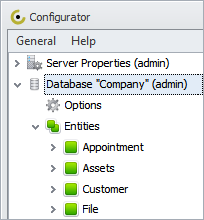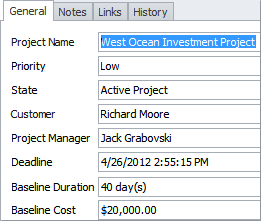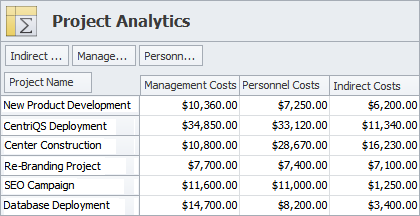Compare Access vs Excel Data Structures
Microsoft Access and Microsoft Excel are powerful data management solutions that make it possible to organize and manipulate business information. Although these programs are originally very different, for many people it is a real challenge to compare Access vs Excel. If you consider between these solutions and also want to explore some alternative solutions to make the final choice, we suggest you take a look at and answer these three basic questions:
- How do you want your data to be organized?
- Do you need database customization?
- What are worthy alternatives available?
Flat or Relational Data Structure?
If you experience trouble in comparing Access vs Excel, first of all you need to take a moment to answer one big question: How do you want your data to be organized?
In the context of database management there are two types of database structures including Flat and Relational.
- A flat database design (also called a "flat-file" or "flat-form" structure) consists of one large table with two dimensions (fields and records). It does not represent complex data relationships. MS Excel uses this database structure.
- A relational database design includes multiple interconnected tables with rows and columns. Each table is composed of records that in turn include fields or attributes. Each field contains a unique value. All tables relate to each other by one or more fields. This relationship enables users to create complex and very large databases consisting of multiple tables. For example: FileMaker and MS Access use this database design.
Your ultimate task is to figure out whether you need a simple flat or a complex relational database to keep and organize your business information. For example, if you want to get total price of all your products in the form of a spreadsheet, then perhaps Microsoft Excel will be the solution of your choice. Excel spreadsheet capability lets you use various formulas to quickly and easily calculate your prices, which can be printed out or included in your sales report.
Or another example: you want to get a complete report on your sales including prices, products, customers, regions, agents, etc. Using a spreadsheet approach to organize this data won't be great as otherwise you have to create and handle multiple spreadsheets in your Excel book. Meanwhile, MS Access lets you create a relational database in which all of your data is organized into tables with multiple rows and columns. You can easily navigate in the database to focus on needed information on products, sales agents, quotes, etc.
Need for Database Customization?
The second question you need to answer is regarding customization capability: Do you want to customize your database according to your business needs?
On the one hand, database customization is a great opportunity to change and organize your data the way you need. MS Access offers you this opportunity. On the other hand, customization in MS Access requires you to be an expert in programming Visual Basic for Application (VBA) and various libraries. If you are not a computer geek and do not look enthusiastically at paying for programming service, then perhaps MS Access won't your choice. As to MS Excel, this software does not feature database customization capability.
CentriQS Business Database as a Worthy Alternative?
So, what software to choose if you want to get a relational database with possibility for data customization? You can try CentriQS which is a great alternative to MS Access. CentriQS supports a relational database design and provides you with a powerful database customization capability. Meanwhile, this software does not require special knowledge in VBA or other programming languages. CentriQS features Configurator that provides an intuitive interface for configuring and customizing your business database. You can create custom entities, properties, workflows, enums, etc. to tailor your database and fit it with your business needs.

Business Database Management Solution
CentriQS offers an all-in-one, multi-user business management solution that helps manage all administrative aspects of your organization. This Access alternative makes control of your administrative processes much easier and less cumbersome, so you are enabled to focus your energy and time on the core business and revenue generating activities. With help of CentriQS database solution you can streamline business processes and improve operations by:
- Managing business projects and tasks
- Monitoring, managing, and reporting on financial and organizational performance
- Driving sales and facilitating customer engagement
- Accelerating service and workforce processes
- Gaining clear visibility across your entire company to improve employee collaboration and communication
Create Business Projects

For example, to manage marketing campaigns, sales activities and promotional events, you can use the Projects view in which your business projects can be specified with a number of properties, such as Cost, Deadline, State, Project Manager, Priority, Customer, Sub-project, and more. To see the tasks and schedules of your projects, you can switch to the Tasks view and to the Scheduler view. The projects can be also linked to any other entities available in your CentriQS database, such as Files, Requests, Contractors, and more.
Analyze and Track Project Costs
To analyze and keep track of project costs in CentriQS database, you can go to the Project Analytics view which lets build and visualize pivot tables. Like MS Access forms, the Project Analytics view lets you create various reports on multiple data that can be saved to presets and also exported to popular file formats (incl. XLS, PDF, BMP, etc.).

Business Accounting and ERP
MS Access and MS Excel are popular solutions among accountants who need to keep a database for tracking, calculating and reporting on accounts payable and accounts receivable. Business accounting records are helpful for ERP, which is the practice of effective planning of business resources. In CentriQS, accountants are enabled to address the same issue.
For example, you can create the Accounts Payable view and the Accounts Receivable view to keep track of current finance records and plan resource use for next periods. The overall financial performance of your business can be displayed and analyzed in the Accounting Analytics view that lets build pivot tables, charts and printable reports.

Prev.: What is Database Software for Business? || Next: Why Use CMS Management System
Next steps
{
Check out CentriQS FEATURES & SCREENSHOTS
Watch 7-minute CentriQS VIDEO OVERVIEW
Learn how to use CentriQS in KNOWLEDGE BASE
DOWNLOAD CentriQS 30-day Free Trial Version
CONTACT US to get help with CentriQS Database Design & Configuration